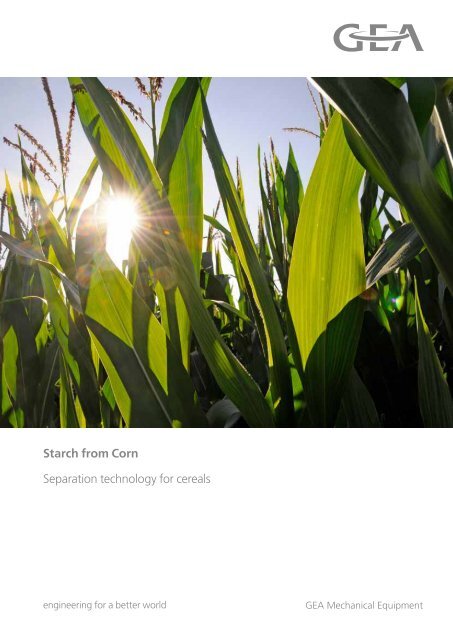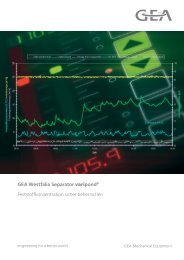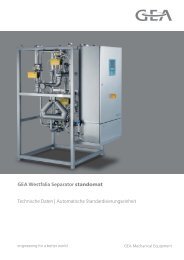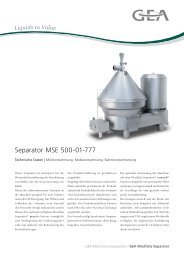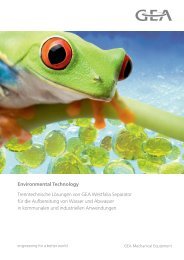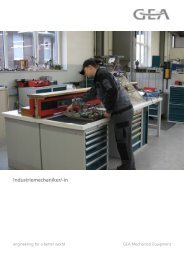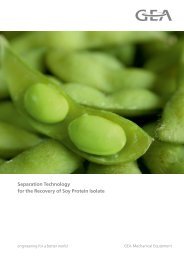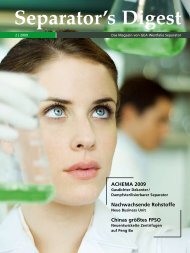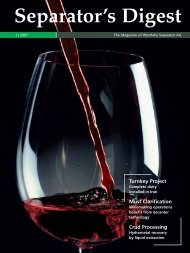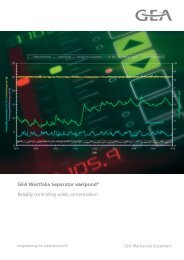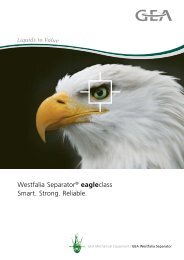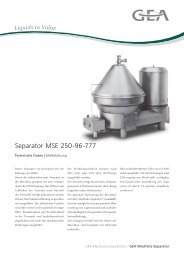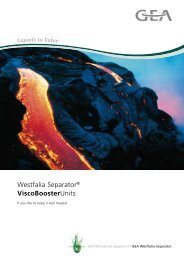Starch from Corn Separation technology for cereals - GEA Westfalia ...
Starch from Corn Separation technology for cereals - GEA Westfalia ...
Starch from Corn Separation technology for cereals - GEA Westfalia ...
You also want an ePaper? Increase the reach of your titles
YUMPU automatically turns print PDFs into web optimized ePapers that Google loves.
<strong>Starch</strong> <strong>from</strong> <strong>Corn</strong><strong>Separation</strong> <strong>technology</strong> <strong>for</strong> <strong>cereals</strong>engineering <strong>for</strong> a better world<strong>GEA</strong> Mechanical Equipment
SCE 53Always the Right Solution<strong>Corn</strong> is worldwide the most important raw material <strong>for</strong> the production of starch andstarch derivates, such as sugar syrups. The corn starch industry introduced centrifugalseparation <strong>technology</strong>, because of the central economic significance and high environmentalstandard <strong>for</strong> such process lines. <strong>GEA</strong> <strong>Westfalia</strong> Separator Group supplies nozzle centrifugesas well as by-product dewatering decanter and has developed many ideas <strong>for</strong> thetechnological beneficial innovations; lately the introduction of the discdecanter andthe SDA 500 (biggest nozzle separator of the world) with direct drive. In the followingthe possible applications of the <strong>GEA</strong> <strong>Westfalia</strong> Separator Group supplied centrifugesare described. Especially the integration of the <strong>GEA</strong> <strong>Westfalia</strong> Separator Group patenteddiscdecanter PA 756 is shown.The morphological structureof a corn kernel is illustratedby this cross section. A specialsteeping procedure is required<strong>for</strong> the selective mechanicaldisintegration of the structure.While the germ and the starchin the floury endosperm arereleased quite easily by gentlecourse grinding, the denselypacked horny endospermrequires a significant input ofmechanical energy to isolatethe starch fraction.• High throughput capacitydue to optimised bowl andscroll design and improvedflow patterns in the bowl• Maximum bowl speeds• Sophisticated drive concepts<strong>for</strong> highest dry substance values• Low energy consumption dueto low friction losses and improved flow patterns• Ease of access to all relevant components reduces maintenancetime, the bowl, scroll and bowl bearings are replaced andexchanged in a <strong>for</strong>m of a complete cassette• Cooling lubrication <strong>for</strong> the bowl bearings and automatic oilcirculation lubrication <strong>for</strong> high running per<strong>for</strong>mance• Liquid phase discharge via internal centripetal pumpSDA 260Two-phase <strong>technology</strong>combining various process stages:• Washing• Classification• Concentration• Desplacement washing• High throughput capacity• Clarifier bowl with closed feed and discharge• Low energy consumption due to continuous dischargeof the solids concentrate through special nozzles• CIP cleaning at operating speed<strong>GEA</strong> <strong>Westfalia</strong> Separator discdecanter PA 756• Newest <strong>technology</strong> <strong>for</strong> gluten de-watering• Highest throughput capacity• Design <strong>for</strong> hydrohermetic feed• Various cone angle of bowl• Regulation of differential speed even <strong>for</strong> low ∆ Dn• High torque because of 2-gear-drive• Low energy concept• Long operation time<strong>Corn</strong>MFreshwaterxBy-productFine Fiber Dewateringto dryingMMMMxMMMMMMillstarch ThickenerMiddlingPrimaryGluten ThickenerMMGluten DewateringHotwaterMMMHotwaterMMGluten<strong>Starch</strong>milkEvaporation<strong>Starch</strong> WashingHusks/FiberGermsSteepingTo achieve an optimum wet milling result thecorn is softened in a steeping process. Thisprocedure is executed batch wise in steeping vessels,designed <strong>for</strong> about 40 – 48 hours residence time.Process water <strong>from</strong> the wet mill containing SO 2and a population of lactic acid bacteria is usedas steepwater, which is pumped through thesteeping system in counter current flowto the intaken corn. The steepwater iscirculated via ECOFLEX heat exchangersto adjust the temperature of 48 – 50 °C. Bythe end of the steeping period the cornshould have absorbed water to about45 % and released a certain portion of thedry substance as solubles into the steepwater. The steepwater which has been inthe steeping system longest is drawn offtowards a steepwater evaporator.Grinding and germ separationIn a pre-milling operation the oil-rich germs are set free bygentle course grinding by means of toothed disc mills. Thegerm separation by means of Hydrocyclones is carried outcounter currently in two stages with a second pre-millingoperation in between. The germs are washed free of starchwith process water by means of a counter current operated3-stage gravity screen system. Afterwards the germ fraction isdewatered in a screw press up to a dry substance of approx. 50 %.Disintegration and extractionThe endosperm fraction passing the underflow ofthe last germ hydrocyclone unit is pre-dewateredon gravity screens in front of fine grinding mills toobtain an effective disintegration of the morphologicalendosperm structure into separable components. Theslurry is pumped through a multi-stage bend screensystem <strong>for</strong> starch extraction and counter current fiberwashing with process water. The fiber fraction <strong>from</strong>the last extraction screen unit is splitted by meansof bend screens into a crude husk fraction, which isefficiently dewatered by a screw press, and fine fiberfraction which is efficiently separated and dewateredby a decanter. Thereby a cumulation of fine fiber in thewet milling process is prevented.<strong>Starch</strong> separation and washingThe crude starch milk <strong>from</strong> fiber extraction still contains besides starch granules sus- pendedmaterial as insoluble protein (gluten) as well as solubles and colloids. A so called mill starchthickener is used to pre-concentrate the crude starch milk in front of the primary separator. Thispre-concentrated mill starch slurry has to be separated into two fractions, the pure starch and thecorn gluten. This is done by primary separation in a nozzle separator where the main starch / glutenseparation takes place into 2 phases, the gluten water with the insoluble gluten and solubles butwithout starch and the starch milk with some gluten and solubles. As usual the starch is dischargedthrough the nozzles while wash liquid is additionally fed in front of the nozzles <strong>for</strong> displacementof soluble and insoluble impurities. The final washing of the starch takes place in a 12-stageHOVEX multi-cyclone system in counter current flow with a minimum amount of fresh wateradded in front of the last hydrocyclone stage. The in-line centrifugal pumps are compensating theloss of operating pressure after each stage. For a constant operation and efficiency of the starchseparation and washing system it is best to operate at a constant density, which is indicated andautomatically controlled via the wash water pressure at the primary separator. A middling nozzleseparator is used to clarify the starch and protein containing overflow <strong>from</strong> the starch washingsystem. The clarified water phase with low soluble potential is used as wash water <strong>for</strong> the primaryseparation. The starch and gluten leaving the middling separator is fed back in front of the primaryseparation.Gluten concentration and dewateringThe gluten water <strong>from</strong> primary separation containsinsoluble gluten and solubles. The insolublegluten has to be pre-concentrated in a nozzleseparator be<strong>for</strong>e the gluten can be dewatered bycentrifugal decanters. Decanters operate veryefficiently with less concentrated glutensuspension, with the ability to achieve maximumdry substance and granular structure of the glutendischarge while the liquid phase is clarified tothat extent, that it can be directly used as processwater. 2-gear drive decanters are used with allconstructional features which are necessary <strong>for</strong>optimum corn gluten dewatering.23 4
Conventional Process<strong>for</strong> <strong>Corn</strong> <strong>Starch</strong> RecoveryMill starchMill starchthickeningProcess waterMiddling separationPrimary separation<strong>Starch</strong> washingGluten thickening<strong>Starch</strong> dewateringGluten dewatering<strong>Starch</strong> dryingGluten drying<strong>Corn</strong> starch<strong>Corn</strong> gluten5
<strong>GEA</strong> <strong>Westfalia</strong> Separator discdecanterTwo in oneThe discdecanter makes the corn gluten dewateringprofitable more than ever. With this revolutionaryinnovation <strong>GEA</strong> <strong>Westfalia</strong> Separator Group succeededin using its know how of separator development <strong>for</strong>decanter <strong>technology</strong>. A disc stack in front of thedecanter’s liquid outlet provides high clarified liquidand there<strong>for</strong>e an extremely dry substance matter.The high quality of the protein powder which becomesobvious because of colour and consistency.Bowl Scroll Disc stackSolidsOverflowFeedAdvantages of the discdecanter• High feed capacity• No cleaning water required <strong>for</strong> filter cloth• No problems with filter cloth• Higher dry substance of dewatered gluten(approx. 42 – 48%)• Less floor space required• Overflow has process water quality(2 Vol-% separable solids)• Better drying conditions because ofvery fine powder• Less energy needed <strong>for</strong> gluten drying6
Drive Concepts <strong>for</strong> SeparatorsDifferent drive concepts are also available <strong>for</strong> the separators. Two drive concepts arein the programme: flat belt and direct drive.Flat belt driveIn this solution, the motor power is transferred to thespindle by means of an antistatic flat belt. Oilcirculation lubrication ensures that bearings arecontinuously lubricated. This also means that theseparator does not have to be shut down <strong>for</strong> an oilchange. Compared to the gear drive, which is still usedin older models, the motor power is transferred withup to 10 percent lower power losses. The belt itself canbe replaced quickly and in a service-friendly mannerwithout the bowl or motor having to be dismantledbe<strong>for</strong>ehand.Direct drive systemThe direct drive is an example of intelligentsimplification in separating <strong>technology</strong>. Whereverthe upper limit <strong>for</strong> gear loads has been reached orbelt drives are undesirable, our separators with directdrive permit virtually loss-free power transmission.This boost in per<strong>for</strong>mance simultaneously reducesthe costs of energy, wear, maintenance and space. Therequired power is transmitted directly to the bowlspindle by a three-phase AC motor with frequencyconverter control via a torsionally elastic clutch.The spindle assembly is likewise supported byrubber-metal cushions. This makes possible lowvibrationrunning at high bowl speeds.At a glance:• Extremely space-saving design• Avoidance of housing de<strong>for</strong>mation• High per<strong>for</strong>mance input• Low maintenance requirement7
2-Phase Separators <strong>for</strong>Applications in a <strong>Corn</strong> <strong>Starch</strong> PlantAs a combination of the traditional 2-phase separation with the latest machine <strong>technology</strong>SDC 70 / 90 nozzle bowl centrifugeWith or without washing device orconcentrate recycling systemSDC 70-..-107 Flat belt driveSDC 70-..-003 Direct driveSDC 90-..-107 Flat belt driveSDC 90-..-003 Direct driveSDC 70. Technical data and capacityInstalled power70 kWNumber of nozzles 12Rated capacity feedmax. 130,000 l / hRated capacity wash water max. 20,000 l / hSDC 90. Technical data and capacityInstalled power90 kWNumber of nozzles 12Rated capacity feedmax. 150,000 l / hRated capacity wash water max. 20,000 l / hSDC 110 / 130 / 160 nozzle bowl centrifugeWith or without washing device orconcentrate recycling systemSDC 110-..-107 Flat belt driveSDC 130-..-107 Flat belt driveSDC 130-..-003 Direct driveSDC 160-..-003 Direct driveSDC 200-..-003 Direct driveSDC 110. Technical data and capacityInstalled power110 kWNumber of nozzles 18Rated capacity feedmax. 160,000 l / hRated capacity wash water max. 40,000 l / hSDC 130. Technical data and capacityInstalled power132 kWNumber of nozzles 18Rated capacity feedmax. 180,000 l / hRated capacity wash water max. 40,000 l / hSDC 160. Technical data and capacityInstalled power160 kWNumber of nozzles 18Rated capacity feedmax. 250,000 l / hRated capacity wash water max. 40,000 l / hSDC 200-..-003 Direct driveInstalled power200 kWNumber of nozzles 18Rated capacity feedmax. 300,000 l / hRated capacity wash water max. 40,000 l / hSDA 260 / 300 / 500 nozzle bowl centrifugeWith or without washing device orconcentrate recycling systemSDC 260-..-107 Flat belt driveSDC 260-..-003 Direct driveSDC 300-..-003 Direct driveSDC 500-..-003 Direct driveSDC 260. Technical data and capacityInstalled Power250 kWNumber of nozzles 20Rated capacity feedmax. 500,000 l / hRated capacity wash water max. 50,000 l / hSDA 300. Technial data and capacityInstalled Power315 kWNumber of nozzles 20Rated capacity feedmax. 400,000 l / hRated capacity wash water max. 50,000 l / hSDA 500. Technial data and capacityInstalled Powerup to 500 kWNumber of nozzles 20Rated capacity feedmax. 500,000 l / hRated capacity wash water max. 50,000 l / hThe feed and wash water volumes are based on water.The effective feed capacity depends both on the productand the process stage.8
2-Phase Decanters <strong>for</strong>Applications in a <strong>Corn</strong> <strong>Starch</strong> PlantAs a combination of the traditional 2-phase separation with the latest machine <strong>technology</strong>SCF 466-01-35Clarifying decanter with centripetal pump and<strong>GEA</strong> <strong>Westfalia</strong> Separator summationdriveTechnical data and capacityBowl diameter460 mmL / D 4Bowl speedmax. 3500 rpmInstalled power45 kW(37 kW with FC)SCE 53.-01-34Clarifying decanter with centripetalpump and differential gear driveTechnical data and capacityBowl diameter530 mmL / D 4Bowl speedmax 3600 rpmInstalled power55 – 90 kW / FCSCE 755-01-32Clarifying decanter with centripetalpump and two-gear driveTechnical data and capacityBowl diameter750 mmL / D 4Bowl speedmax. 2800 rpmInstalled power110 – 200 kW / FCPA 756-00-32discdecanter with additional discstack <strong>for</strong> highly clarified liquidTechnical data and capacityBowl diameter750 mmL / D 4Bowl speedmax. 2630 rpmInstalled power110 – 200 kW / FC9
We live our values.Excellence • Passion • Integrity • Responsibility • <strong>GEA</strong>-versity<strong>GEA</strong> Group is a global engineering company with multi-billion euro sales and operations in more than50 countries. Founded in 1881, the company is one of the largest providers of innovative equipment andprocess <strong>technology</strong>. <strong>GEA</strong> Group is listed in the STOXX ® Europe 600 Index.<strong>GEA</strong> Mechanical Equipment<strong>GEA</strong> <strong>Westfalia</strong> Separator Group GmbHWerner-Habig-Straße 1, 59302 Oelde, GermanyPhone: +49 2522 77-0, Fax: +49 2522 77-1794www.gea.comThe in<strong>for</strong>mation contained in this brochure merely serves as a non-binding description of our products and is without guarantee. Binding in<strong>for</strong>mation, in particular relating to capacity data and suitability <strong>for</strong> specific applications, can only be provided within the framework of concreteinquiries. Printed on chlorine-free bleached paper · Printed in Germany · Subject to modification · <strong>Westfalia</strong> ® and <strong>Westfalia</strong> Separator ® are registered trademarks of <strong>GEA</strong> Mechanical Equipment GmbH. B_RR-12-06-0012 EN


